While flowers may have evolved to function as pollination or fruiting agents, they’ve also taken the time to be pretty and dramatic. We can’t help it – just like the bees, birds, and butterflies, we humans are drawn to their beauty and mystery.
Today, we’ll go over the prettiest and most breathtaking flowers known to man!
Roses
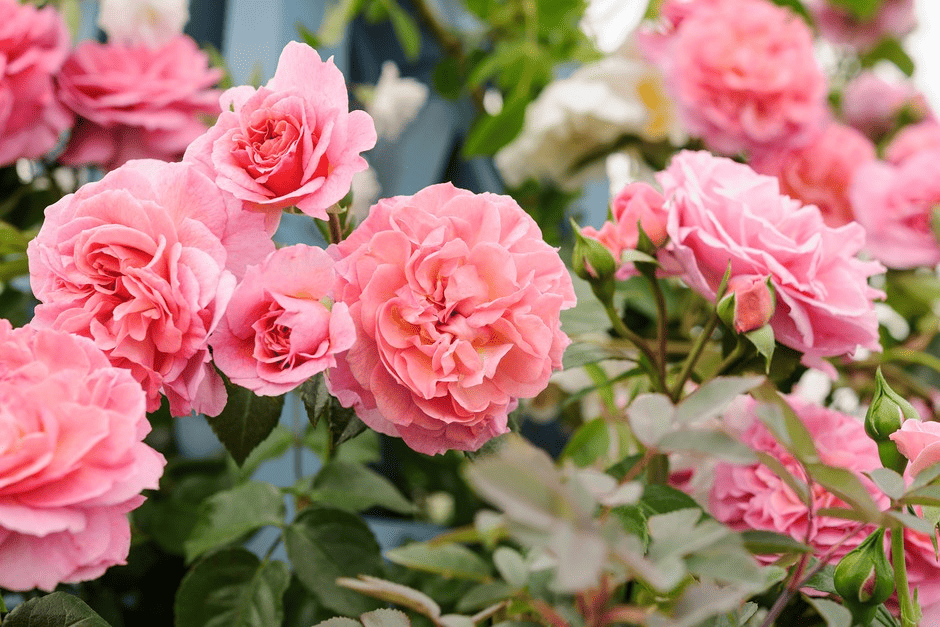
| Ease of Growing | Moderate ●●○○○ |
| Scientific Name | Rosa spp. |
| USDA Zone | 3-9 |
| Outdoors/Indoors | Primarily Outdoors |
| Best Used for | Gardens, Cut Flowers |
| Size | Varies (Dwarf to Climbing varieties) |
| Ideal Light | Full Sun |
| Ideal Soil | Well-draining, Rich Soil |
| Ideal Temperature | 60-75°F (15-24°C) |
| Ideal Watering | Regular, Deep watering |
Roses are loved and grown for their beautiful appearance, with layers of petals in various colors, from bold reds to gentle pinks and whites. They also have a wonderfully pleasant fragrance that’s used extensively in perfumery and cosmetics.
However, some rose varieties have thorns, so handle them carefully. Some cultivars may produce toxins, generally not harmful in small amounts, but worth considering, especially if you have pets or small children.
Sunflowers
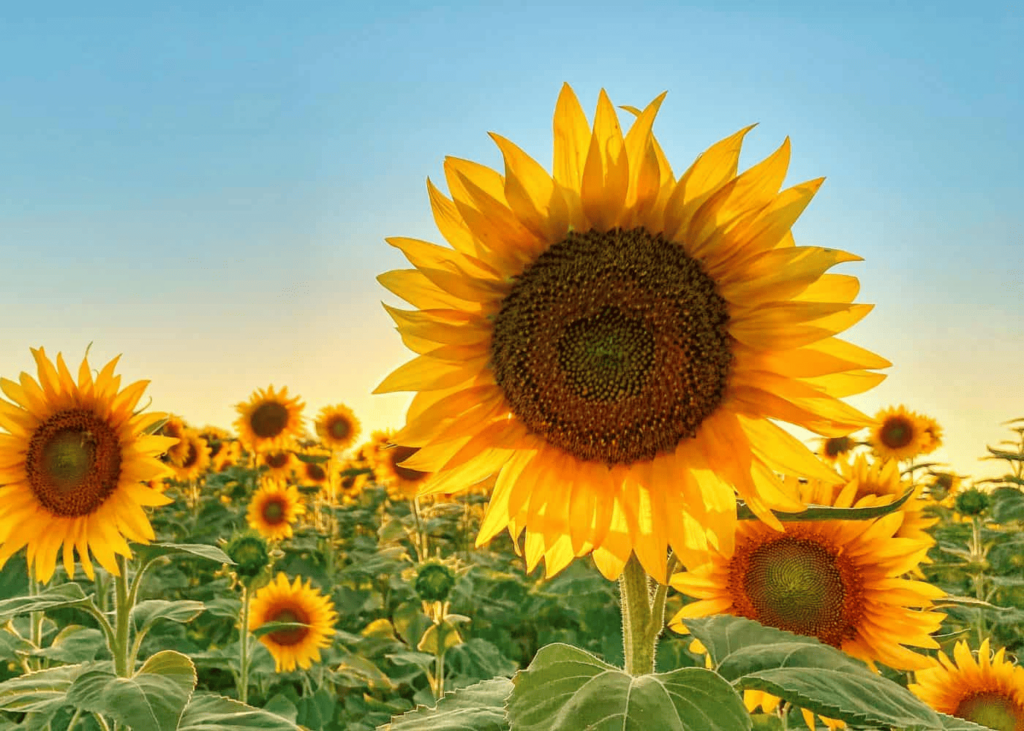
| Ease of Growing | Easy ●○○○○ |
| Scientific Name | Helianthus annuus |
| USDA Zone | 4-10 |
| Outdoors/Indoors | Primarily Outdoors |
| Best Used for | Gardens, Cut Flowers |
| Size | Varies (Dwarf to Giant varieties) |
| Ideal Light | Full Sun |
| Ideal Soil | Well-draining, Fertile Soil |
| Ideal Temperature | 70-78°F (21-26°C) |
| Ideal Watering | Regular, Deep watering |
Sunflowers are known for their lively and bright appearance, featuring large, golden-yellow petals surrounding a dark central disc. They come in various sizes, from compact varieties suitable for gardens to towering giants.
The sunflower’s distinctive trait of turning its face towards the sun during the day is a special characteristic that home gardeners appreciate. People with sunflower seed allergies may, in rare cases, experience reactions such as itching or swelling on contact.
Tulips
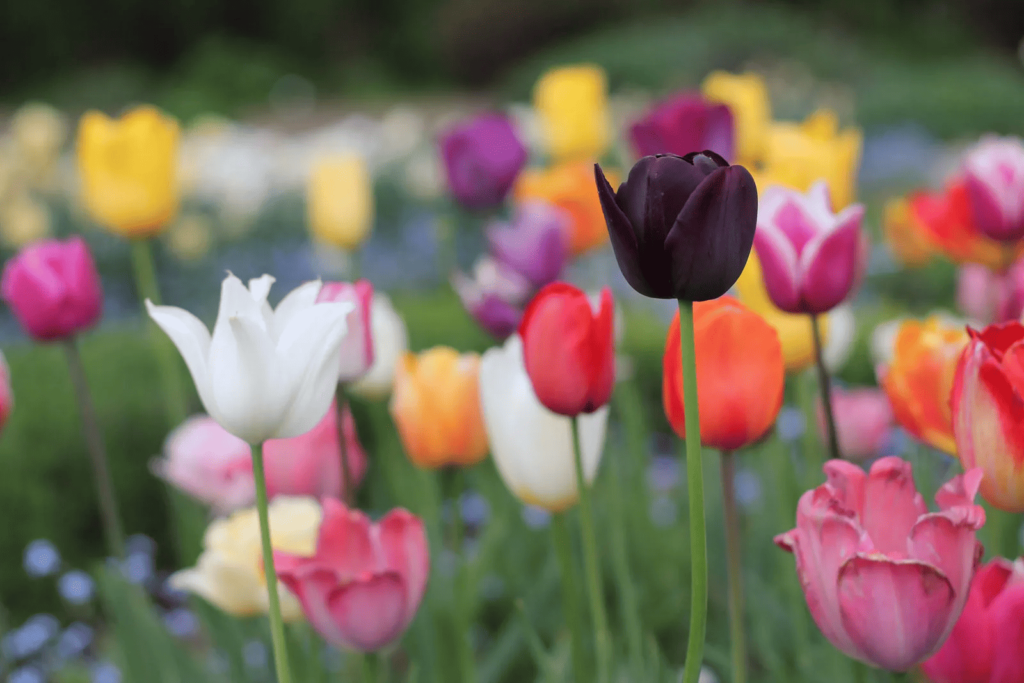
| Ease of Growing | Easy to Moderate ●●○○○ |
| Scientific Name | Tulipa spp. |
| USDA Zone | 3-8 |
| Outdoors/Indoors | Primarily Outdoors |
| Best Used for | Gardens, Containers, Cut Flowers |
| Size | Varies (Short to Tall varieties) |
| Ideal Light | Full Sun to Partial Shade |
| Ideal Soil | Well-draining, Loamy Soil |
| Ideal Temperature | 50-60°F (10-16°C) |
| Ideal Watering | Moderate |
Tulips’ simple cup-shaped flowers display a range of colors, spanning from traditional reds and pinks to more unconventional shades like purples and yellows. The graceful, upright stems and distinct, symmetrical petals make them symbols of simple elegance.
Some individuals may experience skin irritation from contact with tulip bulbs, so it’s advisable to wear gloves during planting. Regarding pets, while tulips are not highly toxic, ingesting them can lead to mild stomach upset, so precautions should be taken.
Peonies
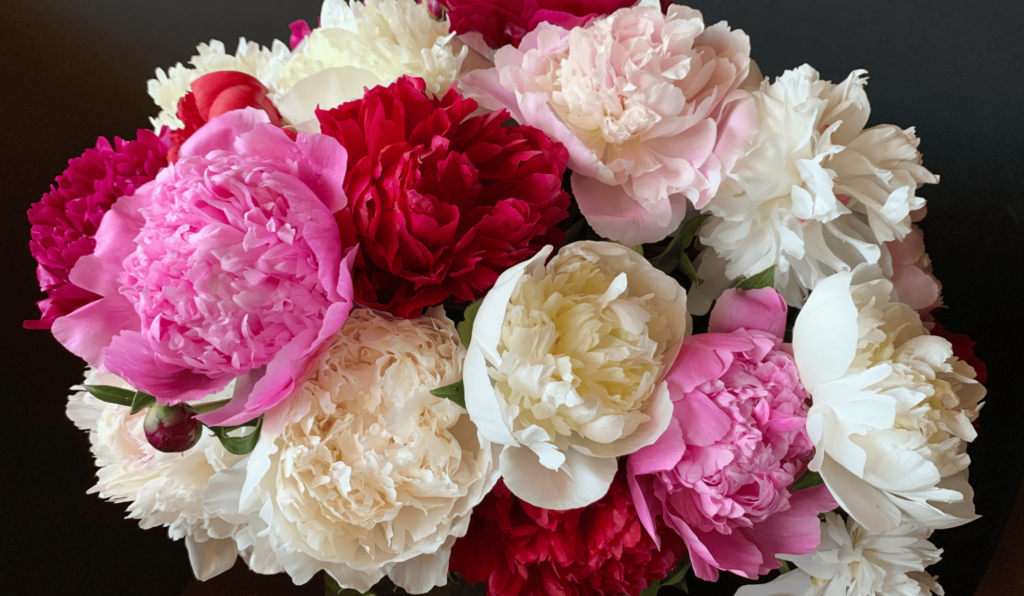
| Ease of Growing | Moderate to Difficult ●●●●○ |
| Scientific Name | Paeonia spp. |
| USDA Zone | 3-8 |
| Outdoors/Indoors | Primarily Outdoors |
| Best Used for | Gardens, Cut Flowers |
| Size | Medium to Large (Bushy growth) |
| Ideal Light | Full Sun to Partial Shade |
| Ideal Soil | Rich, Well-draining Soil |
| Ideal Temperature | 60-70°F (15-21°C) |
| Ideal Watering | Moderate to Regular |
Peonies feature large, layered petals that exude a sense of luxury as the flowers showcase a diverse palette, including soft pinks, whites, and rich reds. Peonies are known for their sweet and delicate fragrance, as well as a symbol of love and romance.
Peonies are generally non-toxic to humans, kids, and pets. However, ingesting the roots of peonies can lead to mild stomach upset, so precautions should be taken, especially in households with curious pets or small children.
Orchid
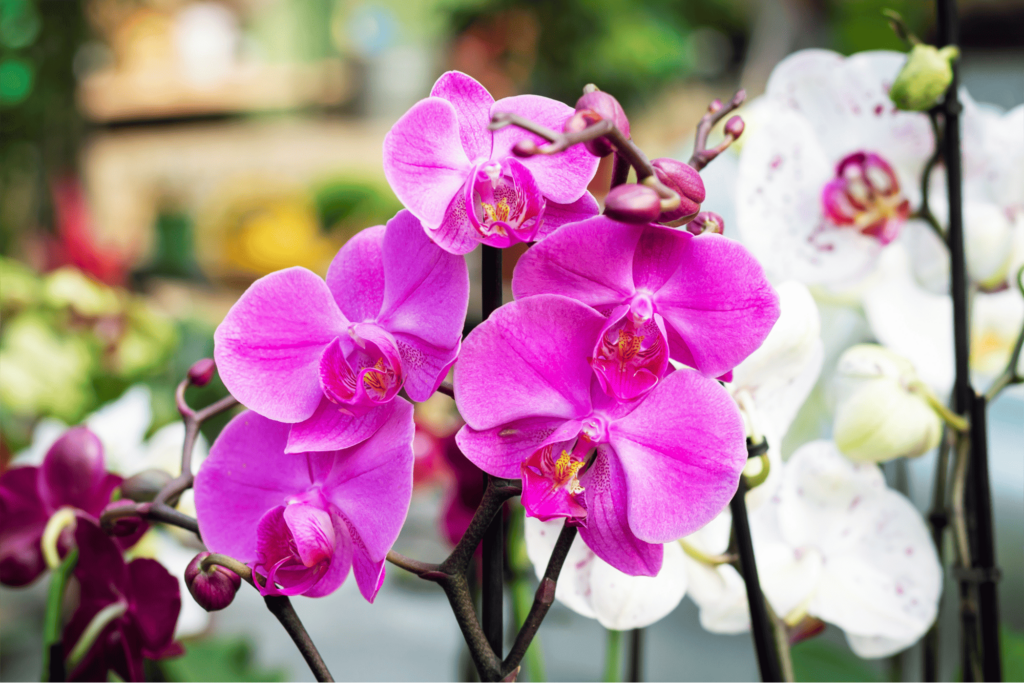
| Ease of Growing | Moderate to Difficult ●●●●○ |
| Scientific Name | Orchidaceae family |
| USDA Zone | Varies (Depends on Orchid species) |
| Outdoors/Indoors | Primarily Indoors (Some outdoor species) |
| Best Used for | Indoor Decor, Orchid Gardens |
| Size | Varies (Compact to Large varieties) |
| Ideal Light | Indirect Bright Light |
| Ideal Soil | Well-draining Orchid Mix |
| Ideal Temperature | 65-75°F (18-24°C) |
| Ideal Watering | Moderate, Consistent |
Orchids are grown for their exotic, distinct, and intricate blossoms that display a diverse array of colors, shapes, and patterns, symbolizing beauty and refinement. Plus, many orchids emit fragrance, making them even more prized.
From the gracefully cascading petals of the classic Phalaenopsis to the vibrant and intricately patterned Oncidium, orchids showcase beautiful diversity. Fortunately for kids and pets, orchids are generally harmless even when ingested accidentally.
Carnations

| Ease of Growing | Easy to Moderate ●●○○○ |
| Scientific Name | Dianthus caryophyllus |
| USDA Zone | 5-9 |
| Outdoors/Indoors | Primarily Outdoors (Can be grown Indoors) |
| Best Used for | Gardens, Cut Flowers |
| Size | Medium (Bushy growth) |
| Ideal Light | Full Sun to Partial Shade |
| Ideal Soil | Well-draining, Neutral to Slightly Alkaline Soil |
| Ideal Temperature | 50-65°F (10-18°C) |
| Ideal Watering | Moderate |
Carnations have frilly petals that come in many colors, like pinks, whites, bright reds, and even two-toned ones. The edges of the petals are a bit fringed, giving them a delicate and textured look.
People like using carnations for different occasions, from bouquets to corsages, because they have a sweet and spicy smell that adds to their appeal. Carnations are generally safe for people, kids, and pets and can be handled and used without worries.
Hydrangea
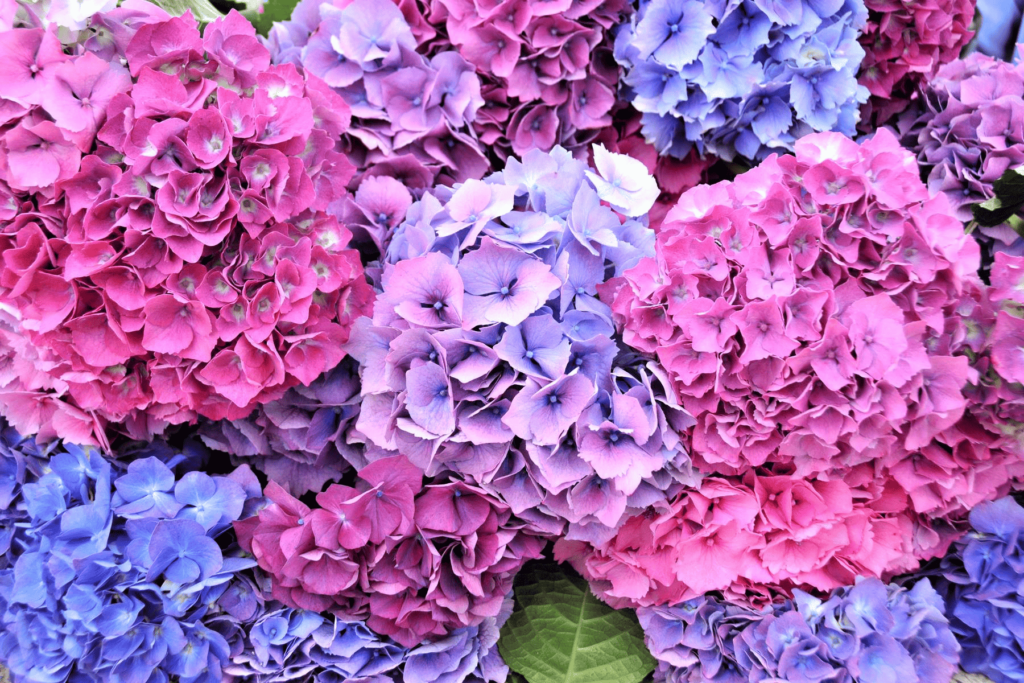
| Ease of Growing | Moderate ●●○○○ |
| Scientific Name | Hydrangea spp. |
| USDA Zone | 3-9 |
| Outdoors/Indoors | Primarily Outdoors (Can be grown Indoors) |
| Best Used for | Gardens, Landscapes, Cut Flowers |
| Size | Varies (Compact to Large shrub varieties) |
| Ideal Light | Partial Shade to Full Sun |
| Ideal Soil | Moist, Well-draining Soil |
| Ideal Temperature | 60-70°F (15-21°C) |
| Ideal Watering | Regular, Adequate water during dry periods |
Hydrangeas are known for their lush, full blooms and a wide variety of colors. These flowers form big, globe-like clusters of small, delicate blooms.
One unique thing about hydrangeas is that they can change color based on the soil’s acidity, giving you shades from blues and purples to pinks and whites. When it comes to safety, hydrangeas are generally safe for people, kids, and pets.
However, some parts of the plant have low levels of cyanide, which could cause mild stomach discomfort if eaten.
Iris
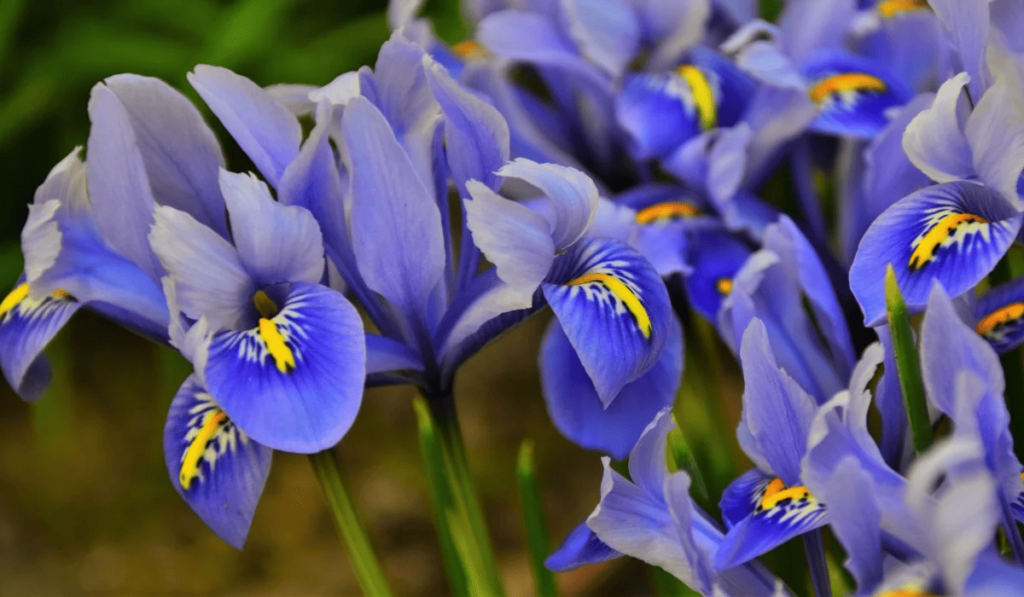
| Ease of Growing | Easy to Moderate ●●○○○ |
| Scientific Name | Iris spp. |
| USDA Zone | 3-9 |
| Outdoors/Indoors | Primarily Outdoors |
| Best Used for | Gardens, Landscapes, Cut Flowers |
| Size | Varies (Depends on Iris species) |
| Ideal Light | Full Sun to Partial Shade |
| Ideal Soil | Well-draining, Loamy Soil |
| Ideal Temperature | 60-70°F (15-21°C) |
| Ideal Watering | Moderate to Low |
Intricate irises display a diverse range of colors and patterns, often featuring petals with contrasting veins and speckles. The bearded iris, with its velvety textured petals and distinctive beard-like structures, is especially popular.
In terms of safety, the graceful iris is generally safe for people, kids, and pets. However, it’s best to avoid eating any part of the iris as consuming any of its plant material may lead to mild stomach upset.
Dahlia
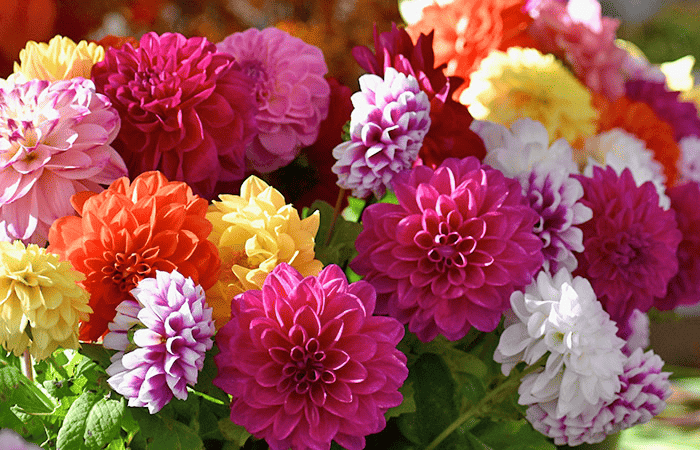
| Ease of Growing | Moderate to Difficult ●●●●○ |
| Scientific Name | Dahlia spp. |
| USDA Zone | 8-11 (Tubers lifted in colder zones) |
| Outdoors/Indoors | Primarily Outdoors (Can be grown Indoors) |
| Best Used for | Gardens, Cut Flowers |
| Size | Varies (Depends on Dahlia variety) |
| Ideal Light | Full Sun |
| Ideal Soil | Well-draining, Rich Soil |
| Ideal Temperature | 60-70°F (15-21°C) |
| Ideal Watering | Regular, Adequate water during dry periods |
Dahlias are well-loved for their beautiful and varied blooms, as they come in different shapes, sizes, and colors, from small, simple petals to big, layered blossoms. They show off a wide range of colors like bright reds, oranges, pinks, yellows, and whites.
One good thing about these flowers is that they’re generally safe for people, kids, and pets. Still, it’s important to be careful not to eat them even if they look deliciously edible, as consuming any part of the plant may lead to a mild stomach upset.
Lilies
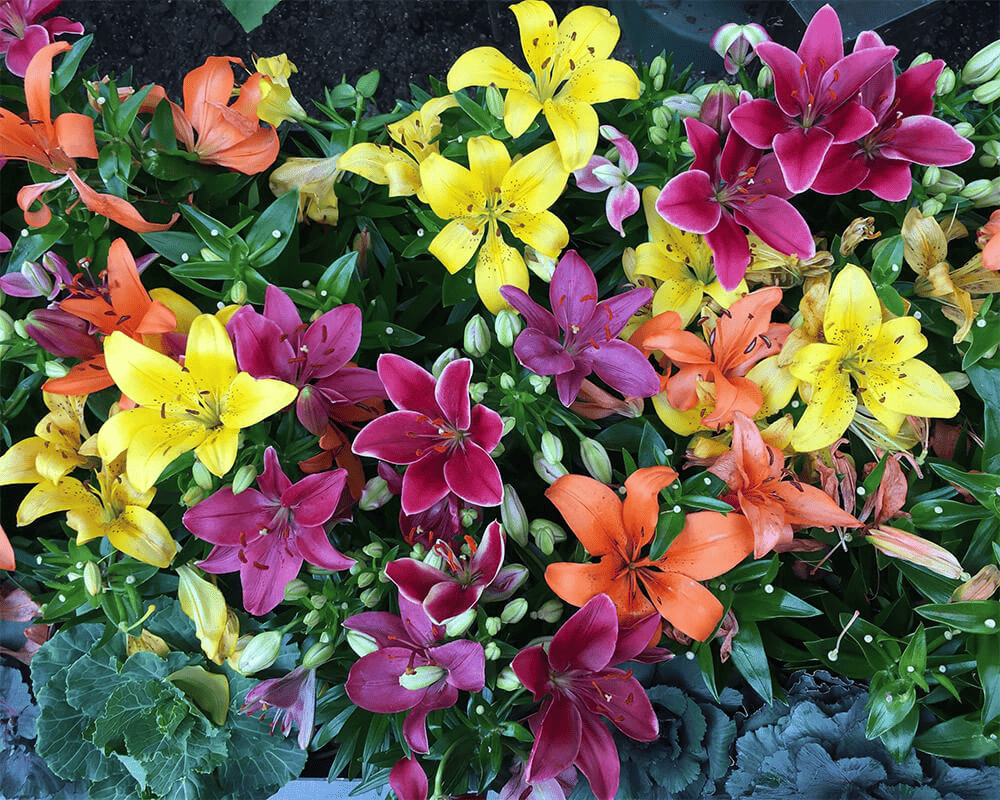
| Ease of Growing | Moderate to Difficult ●●●●○ |
| Scientific Name | Lilium spp. |
| USDA Zone | 3-10 (Depends on Lily variety) |
| Outdoors/Indoors | Primarily Outdoors (Can be grown Indoors) |
| Best Used for | Gardens, Containers, Cut Flowers |
| Size | Varies (Depends on Lily variety) |
| Ideal Light | Full Sun to Partial Shade |
| Ideal Soil | Well-draining, Rich Soil |
| Ideal Temperature | 60-75°F (15-24°C) |
| Ideal Watering | Regular, Adequate water during dry periods |
Lilies are famous for their majestic and classy look, showcasing large, trumpet-shaped blooms that grab your attention. With a wide range of colors like whites, yellows, pinks, and oranges, Lilies bring rich palettes to gardens and bouquets.
While Lilies are usually safe for humans, they can be harmful to cats. All parts of the Lily plant, especially the bulbs, can cause serious kidney damage if a cat ingests them.
For humans and other pets, Lilies are safe.
Daffodil
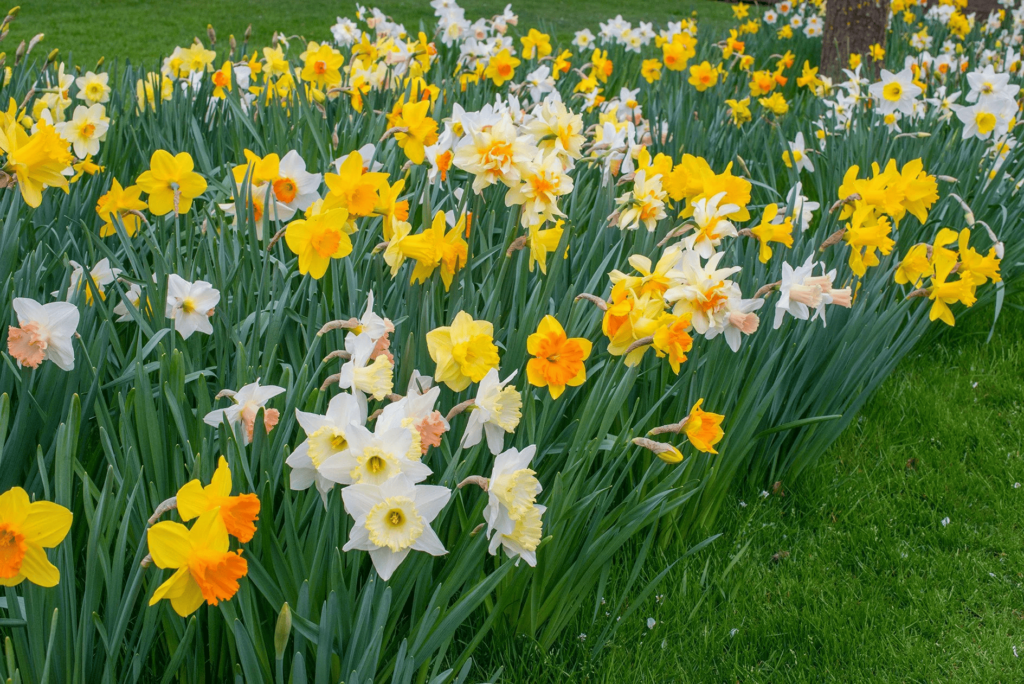
| Ease of Growing | Easy ●○○○○ |
| Scientific Name | Narcissus spp. |
| USDA Zone | 3-9 |
| Outdoors/Indoors | Primarily Outdoors |
| Best Used for | Gardens, Naturalizing, Cut Flowers |
| Size | Varies (Depends on Daffodil variety) |
| Ideal Light | Full Sun to Partial Shade |
| Ideal Soil | Well-draining, Loamy Soil |
| Ideal Temperature | 50-60°F (10-16°C) |
| Ideal Watering | Moderate to Low |
Daffodils announce the arrival of spring with their cheerful and bright blooms. Typically, these flowers have a central trumpet-shaped part surrounded by six petal-like sections.
Daffodils can be found in various colors, including the classic yellow, white, and different combinations. When it comes to safety, Daffodils are generally considered toxic if eaten, as they contain substances that may cause stomach upset and skin irritation.
Chrysanthemum
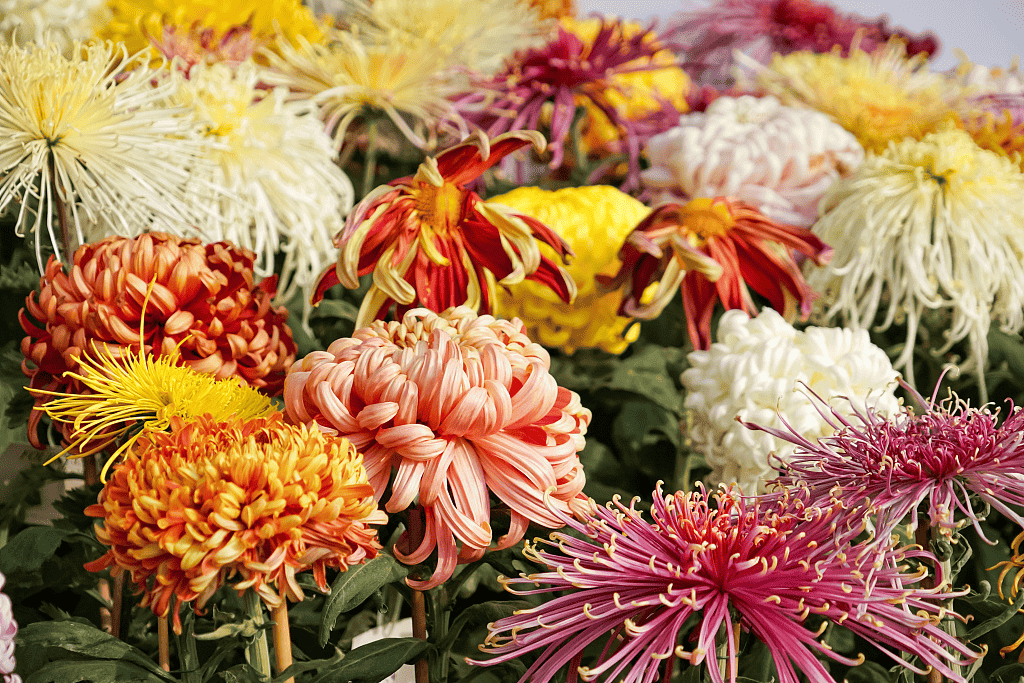
| Ease of Growing | Easy to Moderate ●●○○○ |
| Scientific Name | Chrysanthemum spp. |
| USDA Zone | 5-9 |
| Outdoors/Indoors | Primarily Outdoors (Can be grown Indoors) |
| Best Used for | Gardens, Containers, Cut Flowers |
| Size | Varies (Depends on Chrysanthemum variety) |
| Ideal Light | Full Sun to Partial Shade |
| Ideal Soil | Well-draining, Rich Soil |
| Ideal Temperature | 60-70°F (15-21°C) |
| Ideal Watering | Regular |
Chrysanthemums, commonly known as mums or chrysanths, are admired for their abundant and varied blooms. These flowers come in different shapes, sizes, and colors, ranging from classic daisy-like forms to more intricate pom-pom shapes.
Chrysanthemums display a range of vibrant hues, including whites, yellows, oranges, pinks, and purples. If you have pets, they may have allergic reactions or experience mild stomach upset if they eat chrysanthemum leaves or flowers.
Buttercup
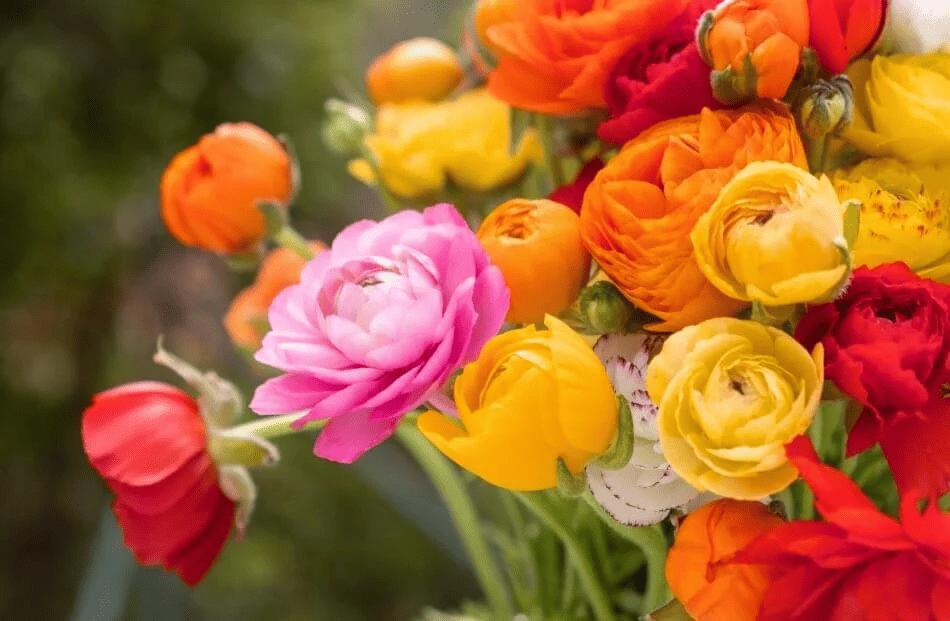
| Ease of Growing | Easy to Moderate ●●○○○ |
| Scientific Name | Ranunculus spp. |
| USDA Zone | Varies (Depends on Buttercup type) |
| Outdoors/Indoors | Primarily Outdoors |
| Best Used for | Gardens, Wildflower Meadows |
| Size | Varies (Depends on Buttercup type) |
| Ideal Light | Full Sun to Partial Shade |
| Ideal Soil | Moist, Well-draining Soil |
| Ideal Temperature | Varies (Typically cool to temperate climates) |
| Ideal Watering | Moderate to Regular |
Buttercups, part of the Ranunculus family, are famous for their vivid and joyful blooms. These flowers usually have shiny yellow petals that form small cups, often linked with spring and early summer, adding sunshine splashes of color to meadows and gardens.
While yellow is the most common color, some species may produce white or pink flowers. It’s important to know that Buttercups contain a substance that, when crushed, can cause skin irritation in some people.
Plus, they’re considered toxic if eaten by humans or animals, so keep pets or small children away from them.
Calla Lilies
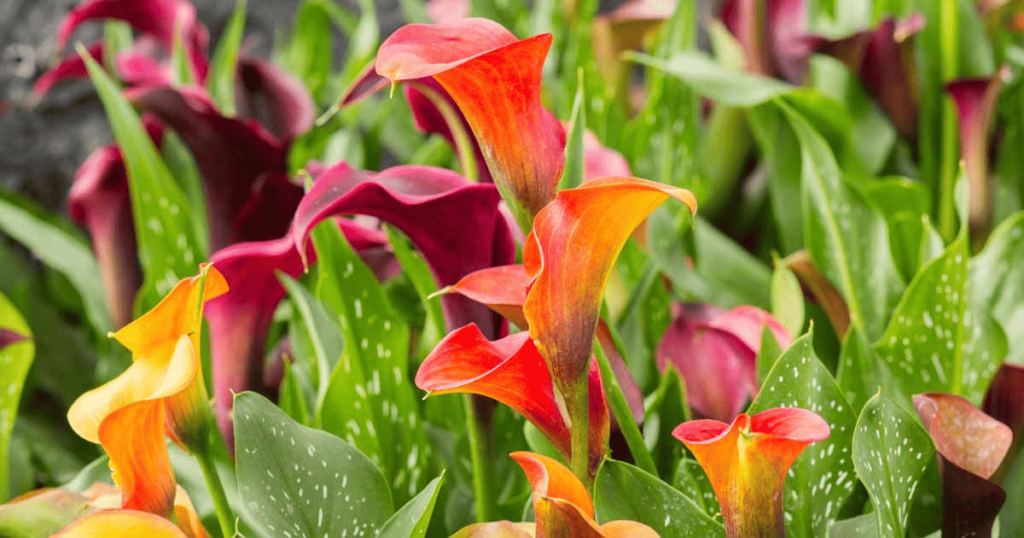
| Ease of Growing | Moderate to Difficult ●●●●○ |
| Scientific Name | Zantedeschia spp. |
| USDA Zone | 8-10 (Can be grown as annuals in colder zones) |
| Outdoors/Indoors | Primarily Outdoors (Can be grown Indoors) |
| Best Used for | Gardens, Containers, Cut Flowers |
| Size | Medium to Large (Depends on variety) |
| Ideal Light | Partial Shade to Full Sun |
| Ideal Soil | Well-draining, Rich Soil |
| Ideal Temperature | 65-75°F (18-24°C) |
| Ideal Watering | Regular, Keep soil consistently moist |
Sculptural and graceful, Calla Lilies have a unique trumpet-shaped structure with a smooth petal wrapped around a central spike. They come in various colors, including the classic white, as well as shades of pink, yellow, and even dark purple.
Calla Lilies are often used in bridal bouquets, floral arrangements, and as stand-alone statement pieces in gardens. Be aware that Calla Lilies contain calcium oxalate crystals, which can cause irritation if ingested or if the plant sap touches the skin.
Gerbera
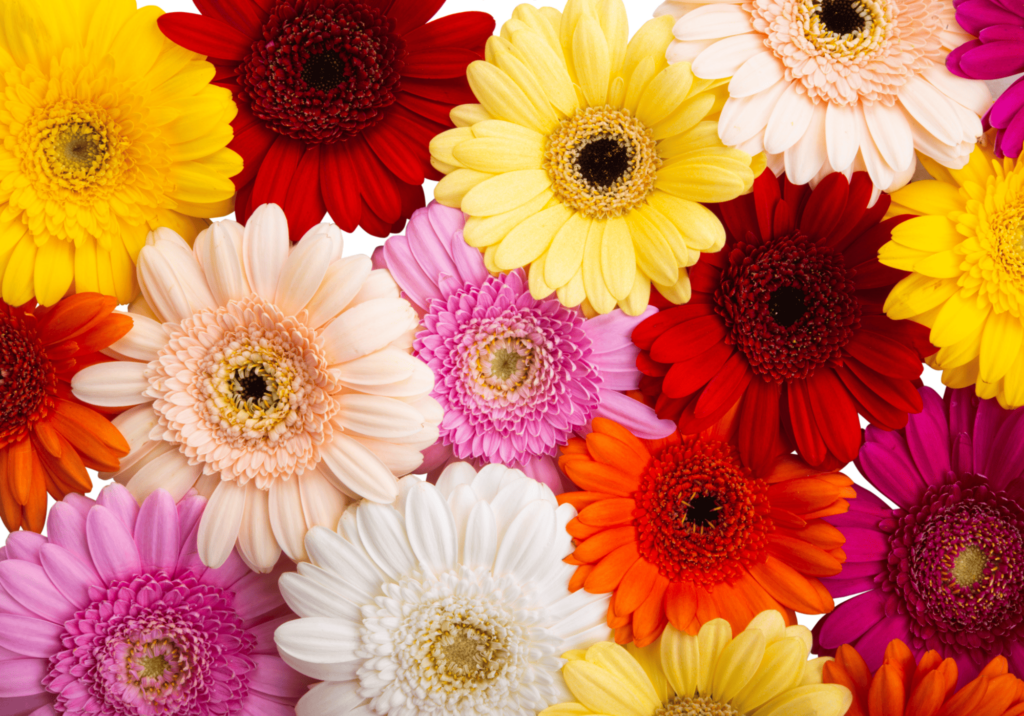
| Ease of Growing | Easy to Moderate ●●○○○ |
| Scientific Name | Gerbera jamesonii |
| USDA Zone | 8-11 (Can be grown as annuals in colder zones) |
| Outdoors/Indoors | Primarily Outdoors (Can be grown Indoors) |
| Best Used for | Gardens, Containers, Cut Flowers |
| Size | Medium to Large (Depends on variety) |
| Ideal Light | Full Sun to Partial Shade |
| Ideal Soil | Well-draining, Rich Soil |
| Ideal Temperature | 60-75°F (15-24°C) |
| Ideal Watering | Regular, Keep soil consistently moist |
Gerbera Daisies are adored for their lively, sizable, daisy-like blossoms that come in a broad spectrum of colors, including vibrant reds, pinks, oranges, yellows, and whites.
Gerberas are cut for their long stems, making them popular choices for bouquets.
Gerbera Daisies are generally safe for humans, pets, and children. They can be handled and used in floral arrangements without worries.
Marigold
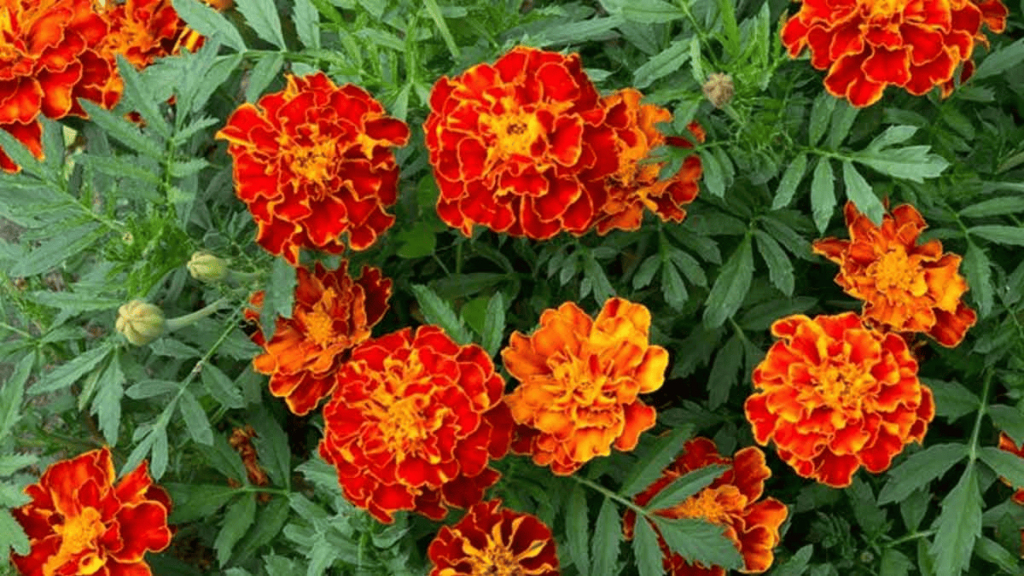
| Ease of Growing | Easy ●○○○○ |
| Scientific Name | Tagetes spp. |
| USDA Zone | 2-11 (Depends on Marigold variety) |
| Outdoors/Indoors | Primarily Outdoors |
| Best Used for | Gardens, Borders, Containers, Companion Planting |
| Size | Small to Medium (Depends on variety) |
| Ideal Light | Full Sun |
| Ideal Soil | Well-draining, Average Soil |
| Ideal Temperature | 70-75°F (21-24°C) |
| Ideal Watering | Moderate |
Cheerful Marigolds flowers have bunches of small, daisy-like blossoms in warm colors like yellow, orange, and red. The leaves smell good, and because they’re not too big, you can use them in many different types of gardens.
Marigolds are not just pretty since they’re also good at keeping away some pests, making them a favorite for planting with vegetables. They’re usually safe for people, pets, and animals and can be touched and planted outdoors without worries.
Daisy
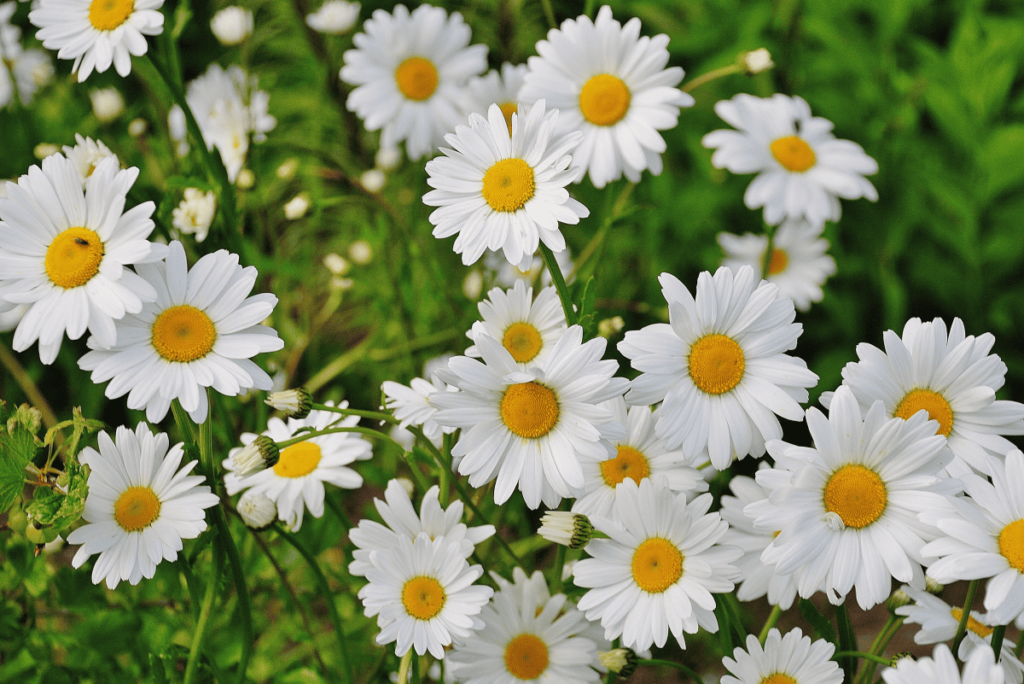
| Ease of Growing | Easy ●○○○○ |
| Scientific Name | Bellis perennis (English Daisy), Leucanthemum vulgare (Oxeye Daisy) |
| USDA Zone | Varies (Depends on Daisy variety) |
| Outdoors/Indoors | Primarily Outdoors |
| Best Used for | Gardens, Ground Covers, Containers |
| Size | Small to Medium (Depends on variety) |
| Ideal Light | Full Sun to Partial Shade |
| Ideal Soil | Well-draining, Average Soil |
| Ideal Temperature | 50-75°F (10-24°C) |
| Ideal Watering | Moderate |
Whether it’s the classic white petals around a yellow center in the English Daisy or the white petals with a yellow disk in the Oxeye Daisy, both kinds have a charming and wholesome look. Their small petals and bright colors create a cheerful easygoing vibe.
Daisies are good at spreading naturally, covering gardens and meadows with delicate blooms. They’re generally safe for people, pets, and children but, like with any flower, some people might have skin sensitivities, so wear gloves when handling them.
Gardenia
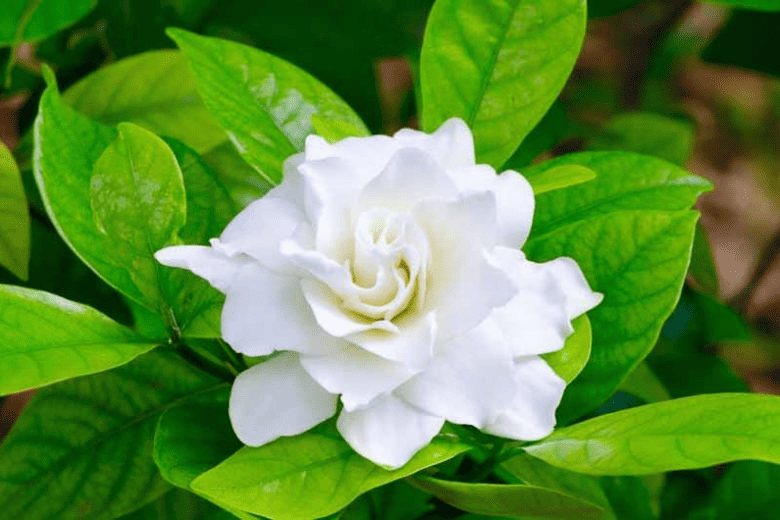
| Ease of Growing | Moderate ●●○○○ |
| Scientific Name | Gardenia spp. |
| USDA Zone | 8-11 (Can be grown as indoor plants in colder zones) |
| Outdoors/Indoors | Primarily Outdoors (Can be grown Indoors) |
| Best Used for | Gardens, Containers, Indoor Decor |
| Size | Medium to Large (Depends on variety) |
| Ideal Light | Partial Shade to Full Sun |
| Ideal Soil | Well-draining, Acidic Soil |
| Ideal Temperature | 65-70°F (18-21°C) |
| Ideal Watering | Regular, Keep soil consistently moist |
Gardenias are known for their elegant and sweet-smelling creamy white flowers, symbolizing beauty and sophistication. The strong, sweet fragrance makes Gardenias popular for both outdoor gardens and indoor decor.
They’re often used in bouquets, corsages, and as centerpieces in gardens, creating a feeling of luxury and calm. While Gardenias are safe for people, it’s not a good idea to eat them, and it’s best to keep them away from pets.
Zinnia
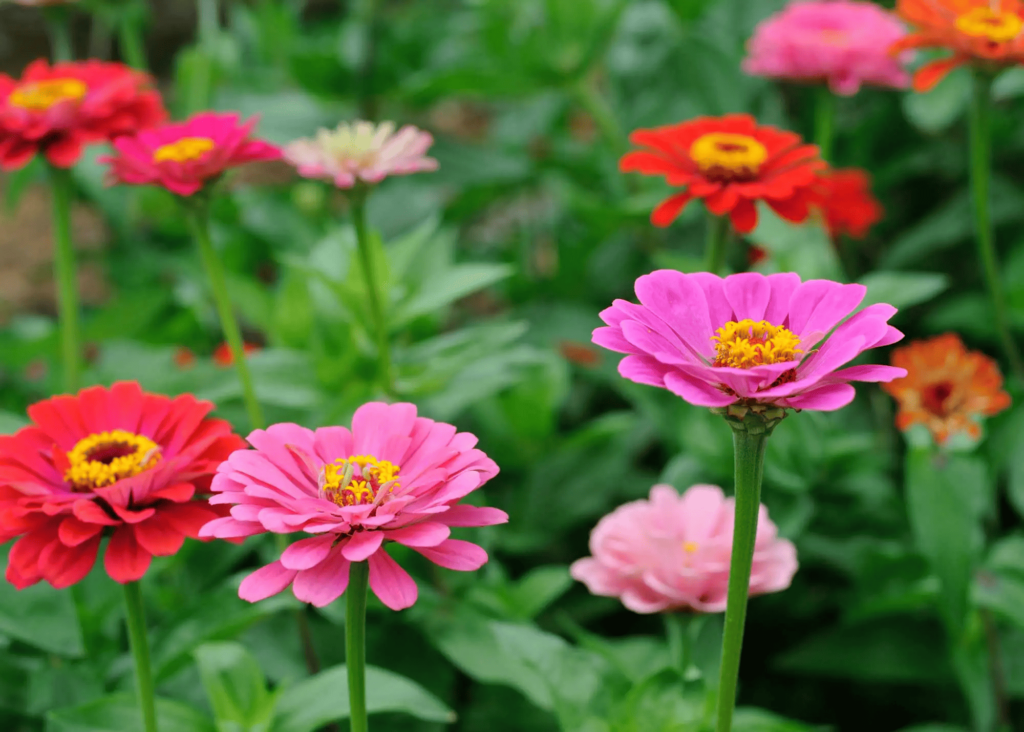
| Ease of Growing | Easy ●○○○○ |
| Scientific Name | Zinnia spp. |
| USDA Zone | 3-10 (Depends on Zinnia variety) |
| Outdoors/Indoors | Primarily Outdoors |
| Best Used for | Gardens, Borders, Cut Flowers |
| Size | Small to Medium (Depends on variety) |
| Ideal Light | Full Sun |
| Ideal Soil | Well-draining, Rich Soil |
| Ideal Temperature | 70-80°F (21-27°C) |
| Ideal Watering | Moderate |
Colorful Zinnias are popular in gardens and flower arrangements since they look like daisies and have one or two layers of petals. These flowers come in different colors like reds, oranges, pinks, yellows, whites, and even mixtures.
Zinnias are also famous for blooming for a long time, bringing color all season. They’re also generally safe for people, pets, and children so you can touch and plant them outdoors without any issues.
Anemone
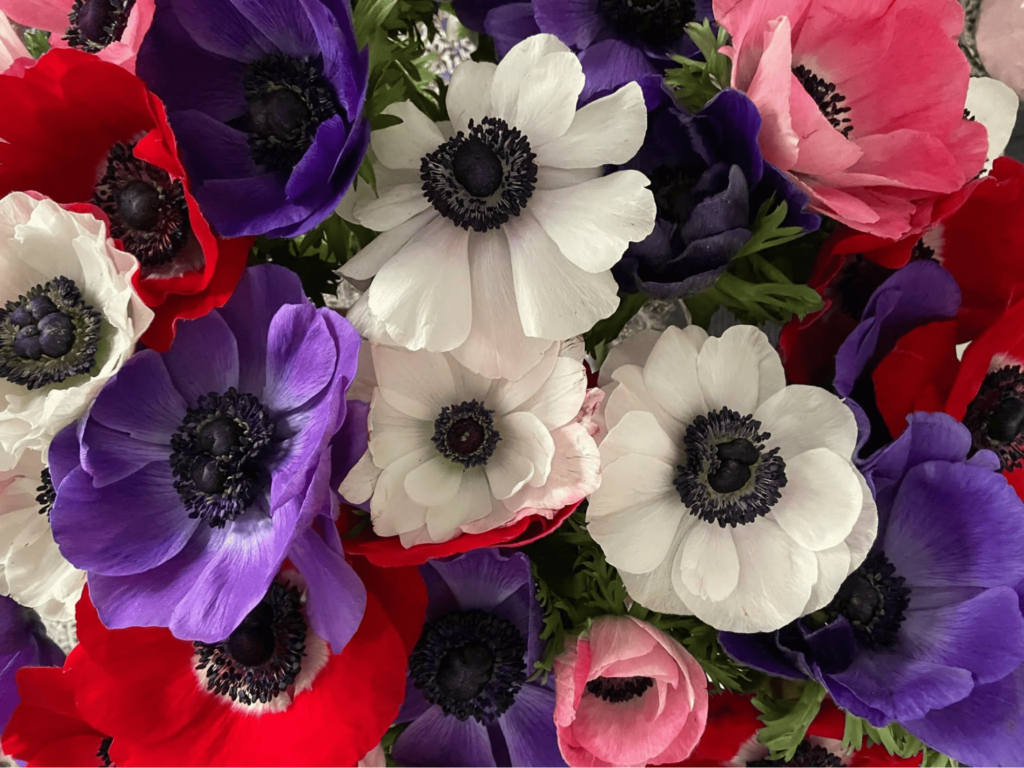
| Ease of Growing | Easy to Moderate ●●○○○ |
| Scientific Name | Anemone spp. |
| USDA Zone | 4-8 (Depends on Anemone variety) |
| Outdoors/Indoors | Primarily Outdoors |
| Best Used for | Gardens, Borders, Cut Flowers |
| Size | Small to Medium (Depends on variety) |
| Ideal Light | Partial Shade to Full Sun |
| Ideal Soil | Well-draining, Moist Soil |
| Ideal Temperature | 55-70°F (13-21°C) |
| Ideal Watering | Moderate to Regular |
Anemones come in different styles, with single and double petals, and a variety of colors like whites, pinks, blues, and purples. The flowers often have a noticeable central disk surrounded by petal-like tepals.
Their whimsical appearance and ability to sway in the breeze make them wonderful additions to garden borders as well as cut flowers. Anemones are usually safe for people but, it’s important to be careful as some people might have skin sensitivities.
Alstroemeria
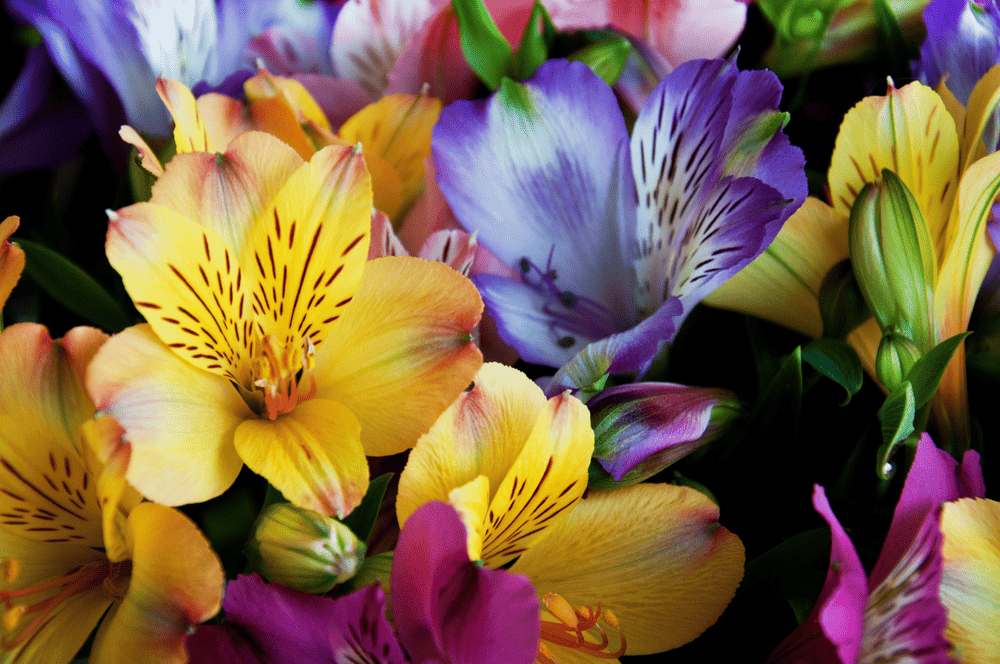
| Ease of Growing | Easy to Moderate ●●○○○ |
| Scientific Name | Alstroemeria spp. |
| USDA Zone | 7-10 (Can be grown as annuals in colder zones) |
| Outdoors/Indoors | Primarily Outdoors (Can be grown Indoors) |
| Best Used for | Gardens, Borders, Cut Flowers |
| Size | Medium (Bushy growth) |
| Ideal Light | Full Sun to Partial Shade |
| Ideal Soil | Well-draining, Rich Soil |
| Ideal Temperature | 60-75°F (15-24°C) |
| Ideal Watering | Moderate to Regular |
Alstroemerias, also called Peruvian Lilies or lilies of the Incas, are loved for their colorful long-lasting blooms. These flowers have clusters of delicate, trumpet-shaped blossoms in colors like pink, orange, yellow, and white.
They can produce flowers all through the growing season, making them valuable for gardens and flower arrangements. In terms of safety, Alstroemerias are generally safe for people and pets.
Asters
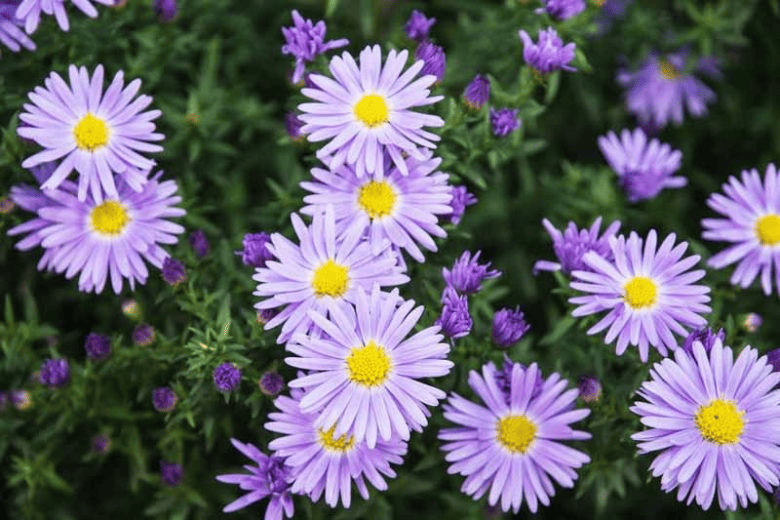
| Ease of Growing | Easy to Moderate ●●○○○ |
| Scientific Name | Aster spp. |
| USDA Zone | 4-9 (Depends on Aster variety) |
| Outdoors/Indoors | Primarily Outdoors |
| Best Used for | Gardens, Borders, Cut Flowers |
| Size | Small to Medium (Depends on variety) |
| Ideal Light | Full Sun to Partial Shade |
| Ideal Soil | Well-draining, Average Soil |
| Ideal Temperature | 60-70°F (15-21°C) |
| Ideal Watering | Moderate |
Asters, with their daisy-like blooms, come in different shapes and colors, like pink, purple, blue, and white. Asters have star-shaped petals around the middle part with leaves that are thick and full, blooming late into the season.
Asters are usually safe for people and pets. But, as with any flower, some people might have skin sensitivities, so it’s a good idea to wear gloves when handling them.
Azalea
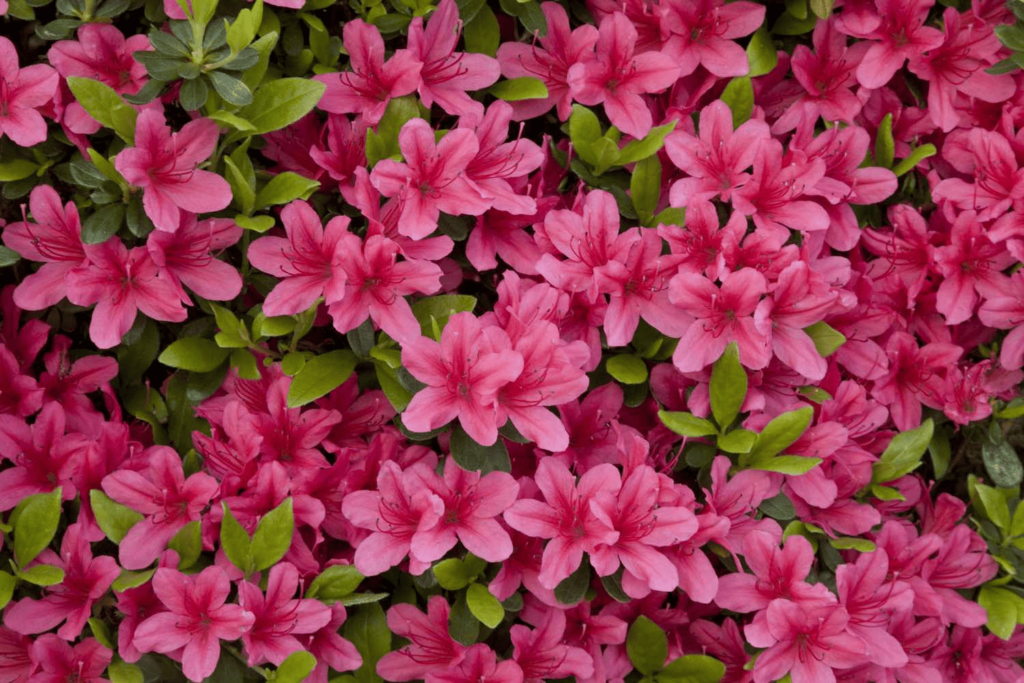
| Ease of Growing | Moderate to Difficult ●●●●○ |
| Scientific Name | Rhododendron spp. |
| USDA Zone | 4-9 (Depends on Azalea variety) |
| Outdoors/Indoors | Primarily Outdoors (Can be grown Indoors) |
| Best Used for | Gardens, Borders, Container Plants |
| Size | Small to Medium (Depends on variety) |
| Ideal Light | Partial Shade to Full Sun |
| Ideal Soil | Well-draining, Acidic Soil |
| Ideal Temperature | 60-75°F (15-24°C) |
| Ideal Watering | Regular, Keep soil consistently moist |
Azaleas, with their plentiful blooms, display different shapes, sizes, and colors, like pink, red, purple, white, and even mixed colors. The blooms are usually funnel-shaped and can cover the shrub, making a stunning display.
Azaleas are flexible plants that can be used as the main attraction in gardens, along borders, or in pots.
Azaleas are considered harmful if eaten, as they contain substances that can be toxic. It’s best to keep them away from children and pets.
Begonia
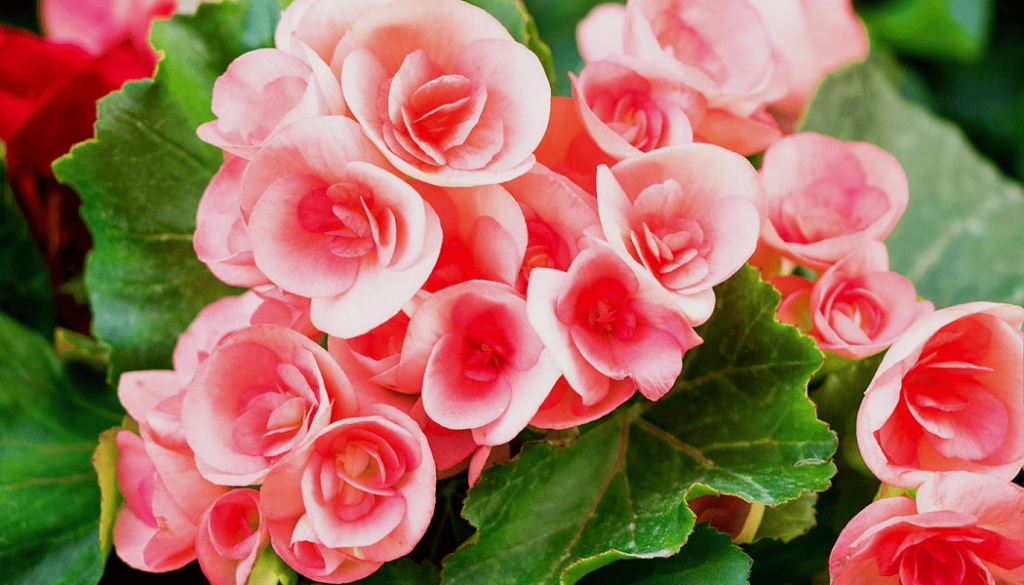
| Ease of Growing | Easy to Moderate ●●○○○ |
| Scientific Name | Begonia spp. |
| USDA Zone | 8-11 (Can be grown as annuals in colder zones) |
| Outdoors/Indoors | Primarily Indoors (Can be grown Outdoors in suitable climates) |
| Best Used for | Gardens, Containers, Indoor Decor |
| Size | Small to Medium (Depends on variety) |
| Ideal Light | Indirect Sunlight to Partial Shade |
| Ideal Soil | Well-draining, Rich Soil |
| Ideal Temperature | 60-75°F (15-24°C) |
| Ideal Watering | Moderate to Regular |
The diversity of begonias means they come in different types, like ones with fibrous roots, tubers, or rhizomes. Begonias have unique leaves in various shapes, sizes, and patterns, from bold and dramatic to delicate and lacy.
Some types also have pretty flowers in pink, red, white, or orange. Begonias are usually safe for people and pets so you can handle and use them indoors and outdoors without any worries.
Poppy
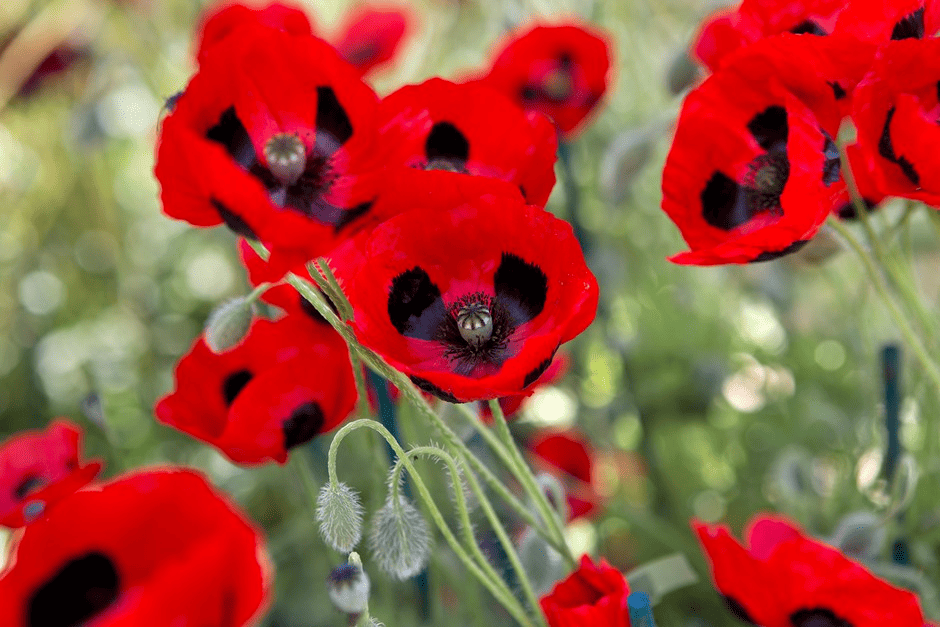
| Ease of Growing | Easy to Moderate ●●○○○ |
| Scientific Name | Papaver spp. |
| USDA Zone | Varies (Depends on Poppy variety) |
| Outdoors/Indoors | Primarily Outdoors |
| Best Used for | Gardens, Wildflower Meadows, Cut Flowers |
| Size | Small to Medium (Depends on variety) |
| Ideal Light | Full Sun |
| Ideal Soil | Well-draining, Loamy Soil |
| Ideal Temperature | 60-75°F (15-24°C) |
| Ideal Watering | Moderate to Low |
Poppies are famous for their colorful and delicate blooms, with flowers coming in different kinds and colors like red, orange, pink, white, and even purple. Poppies usually have papery petals and a big center part, which make them great as cut flowers.
Poppy blooms, known for their striking but short-lived beauty, are ideal for wildflower meadows and cottage gardens. While generally safe for people, it’s important to note that certain Poppy varieties cultivated for opium production may have legal restrictions.





